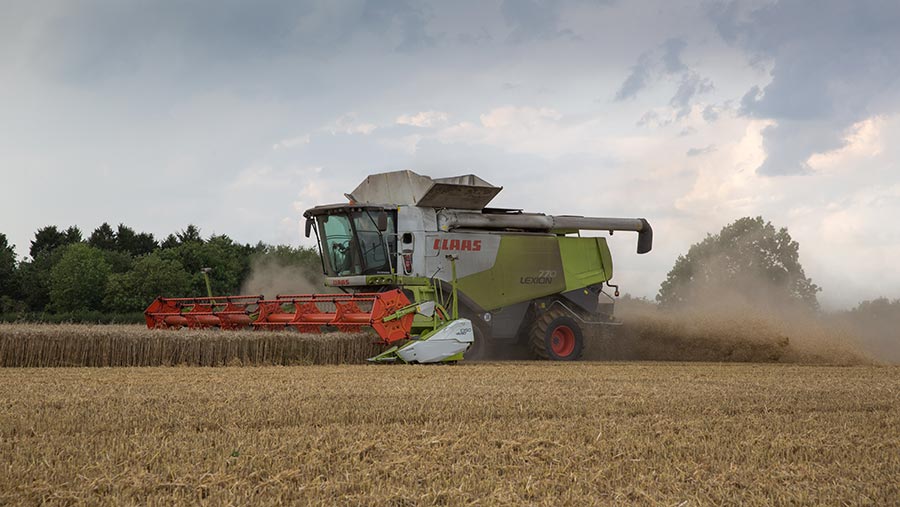Harvest 2018: Late-cut cereals yield well on east coast
 © Tim Scrivener
© Tim Scrivener The end is in sight for the Scottish harvest, with spring barley continuing to disappoint in terms of yield, although quality remains strong.
In East Anglia harvest has restarted for some farmers near the coast, as their crops finally ripened, delivering good yields.
See also: Job profile: What’s it like to be a field trials manager?
Scotland
The Scottish harvest is 80-90% finished, according to Robin Barron, general manager at East of Scotland Farmers. “It’s amazingly easy when the weather is good,” he said.
Yields have been disappointing, particularly on spring barley. “Concerto seems to have yielded lower than Laureate,” Mr Barron said.
The weather had also created a problem with nitrogen. “We have seen much higher nitrogen than usual which is problematic – we won’t know the full extent until the harvest has finished.”
There were also concerns that the dry weather would cause other quality problems, such as thin grains, Mr Baron added. “However, the screenings have been fine.”
Tyne and Wear
Wheat harvest is at least 90% complete around Tyne and Wear, according to Gary Bright, managing director at Grainco. Yields have averaged 8.6t/ha, with feed wheat specific weights between 74kg/hl and 80kg/hl and moistures no higher than 17.5%. “Everything has been unseasonably dry,” he said.
“It’s been interesting to see how well things have generally done it terms of yields,” he said. Although crops had been about 10-15% down on the average, this was better than had been expected earlier in the summer.
“The worst crop regardless of land type has been oilseed rape,” he said.
Spring barley, oats and bean harvesting had mostly begun, with crops beginning to come into store.
He said oats had been a bit disappointing in terms of yield, “but it’s not the Armageddon we expected”.
East Anglia
In Norfolk, harvest had a second coming as the coastal strip of crops ripened after most inland fields had been combined, said Andrew Dewing, chief executive at Dewing Grain.
“Harvest had finished inland, as the weather had been fantastic and dry, but then it rained on and off. Then as of Saturday (1 September), it dried off and people were able to get into their coastal crops.”
Although quality had been good, yields were disappointing on the inland crops, but the coastal strip had benefited from light winds and sea fret, Mr Dewing explained.
This meant that while temperatures soared into the 30s inland, it remained a balmy 18C on the coast, with crops getting moisture from the sea mist.
“This has meant very pleasing yields in the crop,” he said. Yields of wheat inland were 10-20% down on the average, but were about 5% up on the coastal strip. “It’s been very pleasing on the East coast.”
Kelso
Harvest has finished for John Jeffrey at Caverton Mill Farm near Kelso. “The great thing is almost everything came in dry,” he said. “The drying costs were minimal.”
However, yields are down and the straw is minimal, which is frustrating for Mr Jeffrey. “Everyone is desperate for straw this year.”
His 141ha of Lili, Barrel, Skyfall and Revelation wheat averaged 7.4t/ha, performing better on heavier land in comparison with the light land, which suffered in the dry weather, said Mr Jeffrey.
He was pleasantly surprised by his 90ha of Palmedor high erucic acid (Hear) oilseed rape which achieved 4.2t/ha.
However, the Talisman and Pearl winter barley yields are slightly back on last year, averaging 6.6t/ha.
Harvest progress
- Scottish harvest is 80-90% finished
- Wheat harvest was at least 90% complete around Tyne and Wear
- Cutting restarted in East Anglia in coastal areas
- Coastal crops yielding well
Still deciding which winter wheat and barley varieties to grow based on this season performance? Check out our yield maps and see which varieties have performed in the Recommended List trials at your local site this summer.

